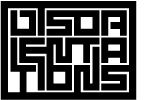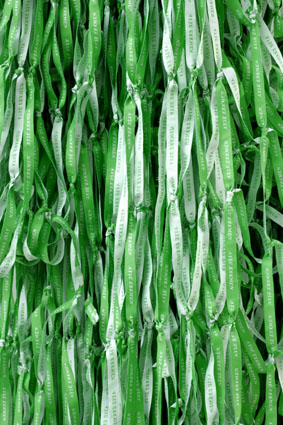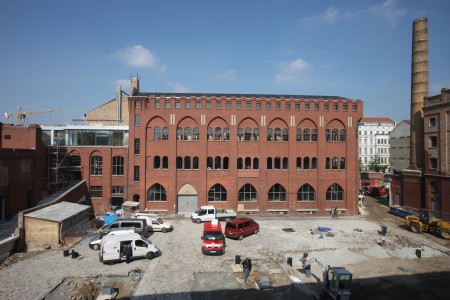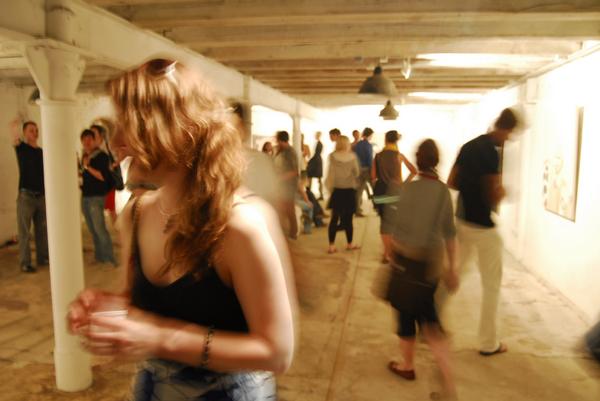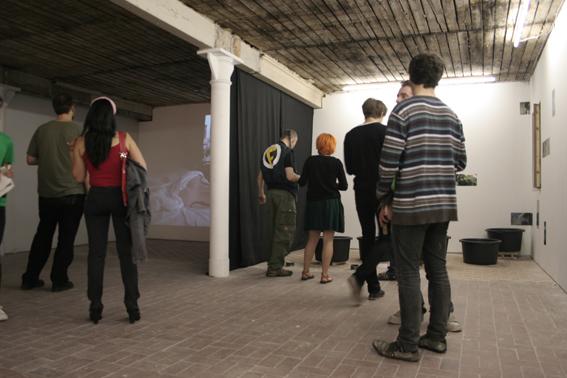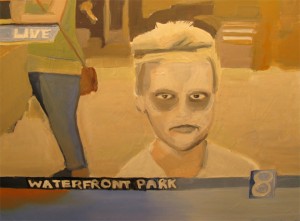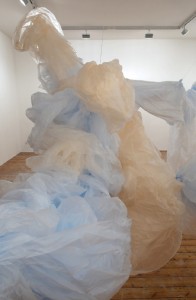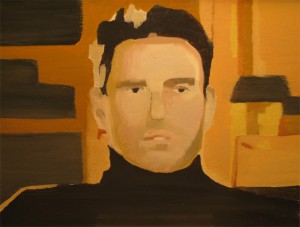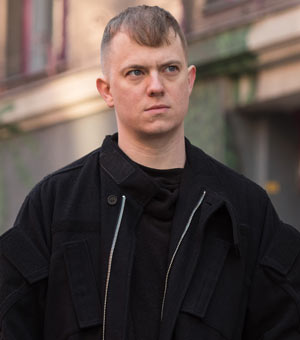Ayse Erkmen at Hamburger Bahnhof, Berlin
by Travis Jeppesen on October 6, 2008
If minimal art has any importance, it’s in making us notice things that we wouldn’t otherwise. Ayse Erkmen has this figured out. She gives us an art that is barely there. What is it that Gertrude Stein once wrote – there is no there there. Or was it someone else? It doesn’t matter who it was: this is how you feel when looking at Ayse Erkmen’s art.
Companions is what she calls this, her latest exhibition. But it’s also the name she gives to her art. The sense of traveling, of a present continuous, and how dizzying that is… You enter through Portiport, a metal detector that probably beeps when you pass through it. The museum guard inspects your ticket. There are signs everywhere, warning you to enter the exhibition at your own risk, and so you are uneasy. The artist wants to threaten the spectators, it seems. But what she really means is that if you don’t look hard enough, you won’t see anything. Or at least, not enough. It is so easy to overlook; thus, let this be a lesson in looking.
The fluorescent lights hanging low from the ceiling in the first room are the most threatening thing. These lights so cold and institutional. Now you can touch them. You are afraid that if you hit one of the wires you will be electrocuted. Perhaps this is what the warning means. Sparks will fly, power will short-circuit, the entire building will be shrouded in darkness. And you will fry. Electric liquid will leak out of your nostrils, your other orifices. No, better not to touch anything.
In the next room there seems to be nothing. This seeming so raw and dignified, you don’t trust it. And so you stand there and wait.
You wait and you stare. Something shifts, a slight change is affected. You’re waiting for something more, it doesn’t come. It is the wall. You go up to it, see that it isn’t really a wall, but a panel. The panel moves – almost imperceptibly, white against white – changing the dynamics of the space ever so slightly. It can give you a headache, this blank ponderousness it induces, so you leave the room, cross the black carpet in the corridor, wind your way up the stairs, past the green and white ribbons upon which Ayse Erkmen has printed her own name.
A word about the ribbons. The ironic striving for a signature is a bit overstated here – that is to say unwarranted. Art that comments on art in general must have something further, beyond the slightness of that commentary, in order to entrap us in the guise of its forepresence. Erkmen doesn’t always get it right. You understand that it’s deliberate in its execution, but it’s still not careful. Another example of this is her usage of photos taken from digital image banks.
I guess I’m resistant to conceptual strategies because it’s so easy in these times we live in to be schooled. What isn’t innate is cheating. Contextual appropriation and all that nudge-nudge wink-wink that comes with it. It lends itself to easy reading – something that every work should defy. Erkmen isn’t exactly a newbie; she should know this and maybe she does.
Still, the failure of certain works included is more than made up for in the upstairs room. You are immediately relieved of whatever high-minded seriousness there has been so far when the White-Tailed Wildebeest, victim of taxidermy, on wheels, greets you at the entrance.
You move further, into the video room. Safety belts have been strapped around the columns supporting the ceiling, forming a network, a blockade. Beeping sounds from the seventeen video monitors form a sort of accidental-intentional sound installation. Induces the feeling of being in a dangerous – yet protected (the safety belts) – space. The monitors are scattered, big black and blocky, so you are constantly having to walk around them in order to see.
The oddness lies in the sheer array of subjects. In one series of films, three-dimensional animated shapes dance by in a straight line making funny noises. Something you might see on a Saturday morning cartoon. Then you read that the cute little shapes are actually replicas of landmines.
A lion snarls. Its sole gesture is stuck on a loop, making it look like it has some kind of tic.
Erkmen’s most poetic – and therefore most unexpected film is Free Time/Idleness. It consists of a barrage of every day images that hold nothing in common except perhaps movement. A house reflected in a canal, the trembling water; a crow walking along the shore; the interior of a car driving down a highway; a palm tree heaving in the wind. The worship of banality becomes a science. Suddenly, all is redeemed, as you see that we live in a world without good or evil, beauty or ugliness. A world marked by the quiet simplicity of being.
Christophe Chemin
by Travis Jeppesen on October 4, 2008
My interview with Christophe Chemin, on the subject of his current exhibition at RISE Berlin, is now online at WhiteHot Magazine.
Olafur Eliasson’s Reading List
by Travis Jeppesen on October 2, 2008
While I agree that Olafur Eliasson’s upcoming professorship at the Universität der Künste in Berlin is a good thing, I don’t know that it’s the revolutionary event that Christy Lange at Frieze makes it out to be.
Looking at the reading list that Eliasson provides in the article linked above, I noticed that there is not a single work of art criticism, poetry, or fiction contained on that list. Instead, Eliasson’s students will be expected to read a bunch of theory and a single biography (of artist Robert Irwin.)
This is hardly a groundbreaking reading list for art school, and in fact, situates Eliasson – and his students – firmly within the institutional nexus that produces so much bad, ideologically-fueled art. Eliasson admits as much in the course of the article:
‘I am constantly navigating institutional architecture,’ he explains, ‘not just as a person but as a studio.’ Eliasson believes that no artistic idea is impervious to these structures and influences.
Okay, Olaf, but that doesn’t mean we all have to dwell in their shadows. If you want your students to think abstractly about sculpture, they’d get a lot more from reading the “difficult” novels of Gertrude Stein than Daniel Birnbaum’s remarks on Husserl’s phenomenology. I’m not saying that theory is completely useless, just that it shouldn’t directly inform artistic practice; I’d rather have it vice versa, to be honest.
I happen to like Eliasson’s work a great deal, but I can’t imagine what anyone would get from studying with him, other than to become an Eliasson clone. At the same time, despite the novelty of Eliasson’s proposed studio, one glance at his reading list asserts that he will do little more than re-assert the institutional status quo. In turn, we can expect a lot more institutional art to come out of his studio – the masturbatory art of today becomes the masturbatory art of tomorrow.
It is a pedagogical necessity to shift away from theory and towards literature, for the simple reason that the former is digestive while the latter is generative. We are bored with art that merely comments on the external world; we are ready for an art that actually forms or disrupts part of that world. Poetry and fiction and theater provide useful departure points for creation in the visual realm, and art criticism provides direct models for different ways of seeing in that realm.
Brewing Art
by Travis Jeppesen on October 1, 2008
While Berlin may not be not be the power or economic epicenter of the international art world at the moment, there is mounting evidence for a case that the city has at least become its spiritual center. Beyond the highly touted cheap rents and ever-obliging coolness factor, which have come to define the post-Cold War nexus of Europes old and new, the secret seems to lie in a young, mostly artist-run gallery scene that is constantly refreshing itself. As soon as one quarter is excessively commercialized and/or gentrified, the young and struggling players who so visibly endow Berlin with its rugged-yet-colorful identity move on to the next ignored or abandoned neighborhood, filling its derelict storefronts and buildings with creations that, if nothing else, pose a much-needed threat to the sort of passion-immunity and numbness-posturing that have sadly come to constitute post-millennial hipsterdom. Where there is a lack of vision or an underflow of talent, there is always plenty of ambition to make up for it; and this, in a nutshell, is what makes Berlin the most vital and inspiring of cities to call home.
Indeed, any effort to keep up with all activities happening outside the burgeoning commercial gallery scene entails keeping an ear to the ground and an eye on the street. Beyond the city’s established gallery districts, there remains a lot to be discovered. And while the prospect of embarking on a week-long treasure hunt through Neuköln, Wedding, or one of the city’s other bastions of underground activity may sound daunting, thankfully the Friedrichshain neighborhood, while weathering a storm of impending gentrification, nevertheless seems to have found its center in one place. That place is the former brewery Friedrichshöhe, a massive building behind a beer garden on the otherwise sleepy Landsberger Allee.
The cooperative that runs the building envision it as a space for the development of fiercely independent art projects and are unconcerned about commercial gains. They have thus turned Friedrichshöhe over to the artists and allowed delightful chaos to ensue. Christopher David, the New Zealand-born photographer and curator behind Kollektiv-Berlin, was the first to move in, bringing with him a barrage of painters, sculptors, installationists, and general havoc-makers, among them the young “analog and digital artist” Nick Dewar, Australian painter Pete Wheeler, and Peruvian street artist Kenno. Next Wednesday, October 8th, to commemorate the closing of Kollektiv’s current exhibition (a group show called Highway Child, curated by Emilie Trice), Kollektiv will be holding a Schwarzer Salon masque ball.
David is in many ways the organizational mastermind behind Friedrichshöhe. A former fashion photographer in London, David currently spends his winters in India, where he is working on a new book project. Given the difficulty of heating the massive Kollektiv project space, he views this as mostly a seasonal project. At the same time, plans are underway to take Kollektiv projects to a larger audience. Plans are underway for Kollektiv to participate in upcoming international art fairs (including the Berliner Kunstsalon), and David himself acts as something of an agent for the artists he represents, securing them shows at commercial galleries for the fall and winter months.
Contemporary photography is the focus of David Mitshu’s eponymous space, which he uses as both a studio and a gallery for showcasing his own work as well as fellow artists working in the medium. Still, other artists working in the building are focusing on transforming the space itself. Such is the project of My Door Organ, a joint venture between Madeline Stillwell and Kate Theodore, which intends to focus exclusively on site-specific installations in and around the gallery space on the second floor.
Across from My Door Organ, Michael Rade and Elena Sinanina recently opened STYX Project Space. Neither Rade nor Sinanina are artists, unlike the others. Rade is a graphic designer by profession, and Russian-born Sinanina is currently completing her degree in Theatre Studies in Berlin, but both have curated exhibitions previously in Germany and the U.K. Thus far, the aim of STYX has been to showcase the work of younger, up-and-coming artists, such as painters Jon Campbell and Jeremiah Palecek and conceptualist Melissa Frost. The gallery has also hosted readings, concerts, and performances. Thomas Götz-von Aust’s riotous literary series Borderline now makes its home at STYX, and Valerie Renay of Noblesse Oblige recently brought her solo performance project Femme Façade into the space.
Much of the current buzz around Friedrichshöhe, however, can be readily attributed to the success of Urban Affairs, a street art festival that brought several thousand visitors to the former brewery this past summer. Urban Affairs was presented under the guise of Riot-Arts, another gallery project in the building, this one the brainchild of entrepreneur Jochen Küpper, and will continue to bring urban artists in off the street, allowing them to experiment in a gallery setting.
Such popular events effectively expose a larger audience to some of the more difficult, experimental projects currently underway at Friedrichshöhe, such as the 91mQ gallery. Run by Italian artists Elena Bellantoni and Marco Giani, they intend to utilize the space as a crossroads between theory and practice. “For us, it’s important to do something different from what you see on the street. It’s also important to have a clean, white space in a building that is rather derelict, dirty. It makes for a nice contrast.” In October, the pair will curate a group show, Same Democracy, which will investigate the ways in which technology has the power to alter the functionality of democracy. A series of artist talks and conferences is scheduled to run concurrently with the exhibition.
If there is a polemical streak to any of these projects, it is perhaps most clearly annunciated by Tulip Art Projects, a Dutch collective also working in the Friedrichshöhe space, whose stated mission is “to develop an antidote to dysfunctional artistry,” which they claim is “common to 99% of all artists.” In a word, the Tulip collective is striving to make art relevant again to a wider public by evading the “delusions of avant-gardeness” and “lifelong dependency on government funds” that have come to define a career in the art world. It is a world that the artists and gallerists currently re-making Friedrichshöhe are each attempting to circumnavigate in their own way, and in so doing, they’re also injecting a much-needed dose of sincerity and realism to a scene that tends to take itself way too seriously.
Friedrichshoehe can be found at Landsberger Allee 54, Berlin.
For more info, check out the following sites:
The Critic as Avant-Garde Artist
by Travis Jeppesen on September 21, 2008
I have to say that I’m a lot more interested now in the prospect of reading Boris Groys’s new book Art Power than I was before reading Brian Dillon’s review of it in the latest issue of Frieze. According to Dillon, Groys argues, among other things, that art criticism “is not necessarily written to be read.” Once you accept this, you are pretty much free to do anything you want:
[L]iberated from the constraints on content and form that cripple academics and journalists, the art critic can potentially write anything at all. Voices and styles ramify, readerly expectations are bravely neglected, and the critic starts to resemble nothing so much as the figure of the avant-garde artist.
This resonates with something I argued back in 2006, when I was reviewing an exhibition of contemporary Slovak painting in Prague for Think Again. I’m pasting an excerpt from that essay below (you can read the entire thing on p. 348-349 of my forthcoming book, Disorientations: Art on the Margins of the “Contemporary”):
What does the new Slovak painting look like? This is the question a new exhibition at the House of the Golden Ring asks. About a year ago, I wrote an article in Um?lec complaining about the lazy strategies of local curators – namely the fact that, instead of coming up with interesting themes for exhibitions, they conservatively bow at the alter of nationalistic ideals. This Is The New Croatian Sculpture. This Is The New Polish Video Art. Etcetera, etcetera. Apparently, no one bothered to read my commentary, or if they did, then they didn’t take my ideas seriously. In fact, it wouldn’t surprise me to hear that no one in this town bothers to read art criticism. This would explain why so many exhibitions are lousy, and why the public has almost no interest in contemporary art.
At the same time, there’s an unprecedented amount of freedom allotted to a writer like me. As a writer that no one reads, I can get away with nearly anything – and I do. I don’t have to feel subservient to any literary tradition, I’m not weighted down with any real journalistic guidelines, I can be as poetic or absurd as I want, as harsh in my judgments as I want. There’s definitely something nice about living in a country where no one really gives a shit about anything.
At the time, in my isolation, I believed that the problem was merely a local one, but now I realize that criticism is ignored across the board.
Now, then, is the time to start writing anything. I’m happy to say that I’m still naïve enough to believe in the figure of the cultural revolutionary, the unseen human force that generates microscopic ripples that eventually give rise to massive waves, and I endorse Groys and Dillon’s projection that the art scribe – the solitary outsider in a closed realm that values power, money, and recognition – has the sole potential to play this role, in that s/he is entitled to none of these advantages.
There is a wolf at the door, it is rabid, and it is on its way inside.
Robert Hughes is Back
by Travis Jeppesen on September 16, 2008
God, I’ve missed Robert Hughes.
Hughes on Damien Hirst:
“His far-famed shark with its pretentious title, The Physical Impossibility of Death in the Mind of Someone Living, is “nature” for those who have no conception of nature, in whose life nature plays no real part except as a shallow emblem, a still from Jaws. It might have had a little more point if Hirst had caught it himself. But of course he didn’t and couldn’t; the job was done by a pro fisherman in Australia, and paid for by Charles Saatchi, that untiring patron of the briefly new.”
Read the rest here.
Jeremiah Palecek
by Travis Jeppesen on September 14, 2008
My review of Jeremiah Palecek’s Berlin show is now online – check it out.
One to Watch Out For: Karla Black
by Travis Jeppesen on September 12, 2008
There’s a great essay by Jonathan Griffin in the latest issue of Frieze on Karla Black, an artist previously unknown to me. Check out images of her recent sculpture There Can Be No Arguments, courtesy of Mary Mary Gallery:
A new formalism?
A Report from ABC – Art Berlin Contemporary
by Travis Jeppesen on September 6, 2008
By now, anyone who has resided in Berlin for any length of time can tell you that all of this city’s “major art events” are the same. You tend to see, if not the same artists, then the same sort of work time and again, with perhaps one or two surprises thrown in. That’s about it. They’re always over-hyped, overrated, and overpopulated, and when attending one of these things – whether it be an art fair or a biennale – you’re always struck by the fact that, despite the large quantity of expertise on hand, these exhibitions are always suffocated by a deprivation of quality in favor of mere novelty.
Art Berlin Contemporary, which opened its doors this week as Berlin’s latest art fair and featuring all Berlin-based galleries, is no exception. While the atmosphere may be less business-like than that of Art Forum Berlin – booths have been abolished in favor of an open floor plan that highlights the art itself, rather than the galleries – the restrictive curatorial approach sought to exclude those working in the hopelessly passé fields of painting and photography in an effort to focus on sculpture, installation, and projected images.
Before I get called a sourpuss, I’d like to point out that the exceptional work I’ve seen at Art Berlin Contemporary. The steel tubes of Ayse Erkmen, subject of an upcoming solo exhibition at Hamburger Bahnhof, remind us that it’s still possible to do something great with next to nothing, as do the floor pieces by Matias Faldbakken, positioned not far from a monumental work by Carl Andre (the wooden Thrones from 1978.) I was also grateful for the chance to see Jimmie Durham’s new sculptural installation, In the air, long before archeology. Jürgen Drescher’s Money Talks installation from the 1980s brings back pleasant memories of the work of Cady Noland and other post-minimal sculptors. One of the few videos I liked, Macellvs L.’s untitle:rope, is projected on a 90-degree corner, and consists of nothing more than a body of water with an oar occasionally disrupting the flow.
I’ve written before about the general malaise that Berlin suffers from (there are plenty of examples scattered throughout my forthcoming book, Disorientations: Art on the Margins of the “Contemporary“.) To sum it up once more, the problem is an oxymoronic one, namely that Berlin is a large city that is also on the periphery. In the international art and news media, it is forever being portrayed as the capital of cool – without any real capital; the city nevertheless responds by playing up to that projected image, despite its meager resources. In the world of contemporary art, this entails an embrace of the “cutting-edge” that is essentially gestural and gimmicky, and winds up looking more like fashion, albeit with plenty of empty political slogans sewn in to give it a “radical” texture. Anyway, it’s Berlin we’re talking about here, so it doesn’t really have to sell anyway. Nearly every gallery represented at Art Berlin Contemporary merely has a branch in Berlin because it’s fashionable; the collectors like to come here for the weekend and slum it up with the jobless artists and fohos that latch on to them; the real business happens elsewhere. Hence, the charm of Berlin for the art world: Here, authenticity comes cheap, and on tap.
What both the media and contemporary art pundits worldwide have not been able to grasp is the real secret behind Berlin’s charm. You want to hear it, kids? Gather round. I’ll whisper it softly. Okay. You ready? Here it is: People leave you the fuck alone here.
Unlike self-proclaimed art world capitals like New York, where every artist is forced to become a whore in order to survive, Berlin allows you plenty of alone time to develop your work outside of the limelight. This is why you won’t see any of Berlin’s best artists represented in Art Berlin Contemporary – most of them are working outside of the official art world’s radar, and are doing just fine. They’ll be discovered eventually, sure, but they’re in no hurry, as they’re too busy making work and enjoying life – and yes, Berlin allows you to do both simultaneously, without starving to death. Events like Art Berlin Contemporary do a good job of concealing the reality of both life and art here to the larger art world, and Berliners largely ignore events like Art Berlin Contemporary, events that are more interested in pandering to the skewed perceptions of the masses than they are in representing the concerns of artists unable and unwilling to conform to the narrow standards of “the real Berlin.”
Jeremiah Palecek
by Travis Jeppesen on September 5, 2008
Check out footage from Jeremiah Palecek’s recent opening at STYX Project Space in Berlin at his blog. I will be reviewing Palecek’s show for White Hot Magazine in the coming days, so stay tuned!
